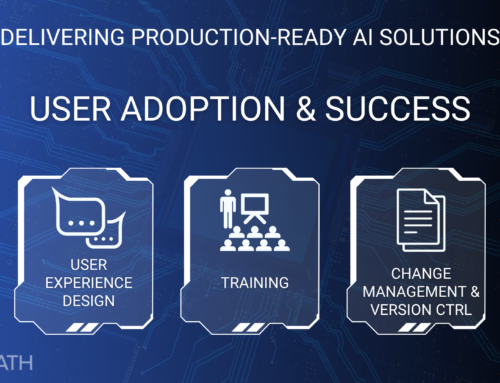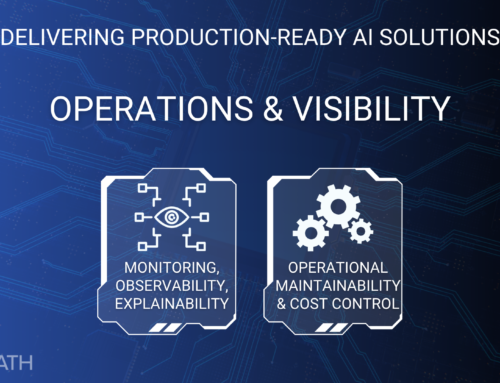When you're wearing multiple hats in a growing business (managing operations, creating content, coordinating teams, running projects) everything feels like a priority. The instinct is to look for a comprehensive solution that addresses all the chaos at once. But that approach rarely works.
Successful AI implementation doesn't start with trying to solve everything. It starts with systematic analysis: breaking down your operations into discrete processes, identifying which bottlenecks actually constrain business results, and selecting one or two high-value use cases for initial implementation.
This article walks through a practical framework for analyzing business operations, decomposing complex roles into specific AI opportunities, and selecting quick wins that build momentum while delivering measurable value.
The Analysis Framework: From Chaos to Clarity
Step 1: Document What Actually Happens
Start by mapping how you currently spend time, not how you think you spend it or how you wish you spent it:
Time audit over 2-3 weeks. Track tasks in reasonable detail, not minute-by-minute, but enough to understand patterns. What activities consume multiple hours per week? What interrupts deep work? What gets done late at night because there's no time during the day?
Distinguish between task types:
- Creation work: Writing, designing, building, developing strategy
- Processing work: Reviewing, approving, categorizing, extracting information
- Coordination work: Scheduling, communicating, following up, tracking status
- Analysis work: Reviewing data, generating insights, creating reports
- Administrative work: Data entry, filing, updating systems, maintaining records
Identify repetition. Which tasks happen regularly with similar patterns? Repetitive work with consistent structure is often automatable. One-off strategic decisions typically aren't.
Step 2: Connect Activities to Business Impact
Not all time-consuming work is equally important:
Which activities directly drive business results? Some tasks (creating content that attracts customers, developing strategy that differentiates you, building relationships that generate revenue) have clear business value. These deserve your time.
Which activities enable results but don't create them? Coordinating meetings, processing information, maintaining systems, generating reports… these are necessary but not sufficient. They're often excellent automation candidates because automating them frees capacity for higher-value work.
Which activities are overhead with minimal impact? Some tasks exist because they've always existed, not because they deliver value. Consider eliminating them rather than automating them.
What's the cost of delays? Some bottlenecks have disproportionate impact. If slow content production means you can't execute marketing strategy, that's costly. If delayed data processing means decisions get made with old information, that creates risk.
Step 3: Break Down Complex Roles into Specific Use Cases
Roles like "marketing manager," "operations coordinator," or "business analyst" encompass many distinct activities. Decompose them into specific, implementable use cases.
Example: Marketing Operations Role
Instead of "automate marketing," break it into discrete possibilities:
- Content creation: Generating blog posts, social media content, email campaigns based on strategic direction and brand voice
- Competitive monitoring: Tracking competitor content, messaging, product announcements, and positioning
- Lead research: Investigating companies that engage with your content or fill out forms to determine fit and priority
- Performance reporting: Analyzing campaign data and generating insights about what's working
- Content repurposing: Converting webinars into blog posts, blog posts into social content, long-form into multiple formats
- Campaign coordination: Managing workflow status, following up on tasks, tracking deliverables
Each of these is a distinct use case with different implementation requirements, business value, and complexity.
Example: Operations Management Role
Instead of "streamline operations," identify specific opportunities:
- Document processing: Extracting data from invoices, contracts, purchase orders, or vendor documents
- Status reporting: Collecting updates from various systems and generating executive summaries
- Knowledge management: Capturing and organizing process documentation, making it accessible to team members
- Compliance monitoring: Tracking regulatory requirements and flagging when actions are needed
- Vendor research: Investigating potential vendors, comparing offerings, summarizing capabilities
Example: Customer Success Role
Instead of "improve customer experience," specify possibilities:
- Support ticket analysis: Identifying patterns in customer issues, flagging escalation risks, suggesting solutions
- Customer communication: Generating personalized check-ins, renewal reminders, or educational content
- Usage analysis: Monitoring product adoption and identifying customers who need intervention
- Knowledge base maintenance: Keeping help documentation current and comprehensive
- Feedback synthesis: Analyzing customer feedback from multiple sources and identifying themes
Step 4: Evaluate Each Use Case
For each potential use case, assess viability:
Business value:
- How much time would this save per week?
- What higher-value work would freed capacity enable?
- What business outcomes would improve (revenue, retention, decision speed, quality)?
- Can you quantify the value in dollars or strategic impact?
Implementation complexity:
- Is the task repetitive and structured, or does it require significant judgment?
- Do you have the data or content needed for the AI to work with?
- Are there existing systems to integrate with?
- What's the realistic implementation timeline?
Success measurability:
- Can you define clear success criteria?
- Will improvement be obvious to stakeholders?
- Can you measure before/after performance?
Strategic alignment:
- Does this connect to documented business priorities?
- Does it address a genuine bottleneck or just an annoyance?
- Will success build momentum for additional AI initiatives?
Selecting Your Quick Wins
Don't try to implement everything simultaneously. Choose 1-2 initial use cases strategically:
Characteristics of Good Quick Wins
High value, manageable complexity. Look for use cases that deliver substantial time savings or business impact but don't require months of implementation. Target 4-8 weeks from decision to measurable results.
Clear success criteria. Choose use cases where improvement is obvious and measurable. Avoid ambiguous situations where success is debatable.
Repetitive and high-volume. Tasks you do weekly or daily deliver faster ROI than occasional activities. If you spend 5 hours weekly on something, automating it delivers 250+ hours annually.
Enables higher-value work. The best quick wins don't just save time. They free you to do work that genuinely moves the business forward. If automating task X means you can finally focus on strategic priority Y, that compounds value.
Builds organizational capability. Your first implementation teaches important lessons about scoping AI projects, validating quality, managing change, and measuring impact. These lessons transfer to future use cases.
Common Quick Win Patterns
Certain use case types consistently deliver fast value:
Content generation with clear parameters. If you're producing similar content repeatedly (social media posts, email campaigns, product descriptions, blog outlines), AI-assisted creation can dramatically increase output while maintaining quality through human review and refinement.
Information extraction from documents. If you regularly pull data from invoices, contracts, resumes, forms, or reports, automated extraction eliminates tedious manual work and improves consistency.
Competitive or market intelligence. If you spend hours manually checking competitor websites, tracking industry news, or researching companies, automated monitoring delivers both time savings and faster insights.
Summarization and synthesis. If you read lengthy documents, customer feedback, or reports to extract key points, AI summarization can reduce reading time by 60-80% while ensuring nothing critical is missed.
Research and enrichment. If you regularly research companies, contacts, or topics to gather background information, automated research can handle initial data gathering while you focus on analysis and decision-making.
What to Avoid in First Implementations
Some use cases, while potentially valuable, are poor choices for initial implementations:
High-stakes decisions requiring deep expertise. Don't start with use cases where errors have serious consequences and require sophisticated judgment. Build confidence with lower-risk applications first.
Highly customized or unique processes. Processes that work completely differently from standard patterns are harder to implement. Start with use cases that follow more common patterns.
Use cases requiring extensive integration. If implementation requires connecting to five different systems and complex data flows, save it for later after you've built technical capability with simpler projects.
Problems without clear success metrics. If you can't define what "good" looks like or measure improvement, you can't validate success. Start where measurement is straightforward.
Implementation Approach for Quick Wins
Once you've selected your use cases, implement them with appropriate discipline:
Validate Before Building
Don't assume your analysis is correct:
Manual simulation. Before automating, manually perform the process in the way you envision AI handling it. Does it actually work? What challenges arise? This costs a few hours but reveals problems before investing in implementation.
Scope verification. Confirm that the use case is genuinely representative and high-volume enough to justify automation. One-off tasks disguised as recurring work waste implementation effort.
Stakeholder alignment. If others will use or be affected by the system, validate that they agree it addresses a real problem and would adopt a solution.
Implement Minimally
For quick wins, avoid over-engineering:
Start with the simplest implementation that could work. You can always add sophistication later. Often a straightforward approach delivers 80% of the value with 20% of the complexity.
Plan for human review initially. Don't try to achieve full automation immediately. Having humans verify outputs builds trust, catches errors, and helps you understand where the system needs improvement.
Use existing tools when possible. If commercial tools exist that solve 70% of your problem, use them rather than building custom solutions. You can always build custom solutions later if needed.
Measure Rigorously
Even for quick wins, track results:
Before metrics: Document current time spent, error rates, and business outcomes before implementation.
After metrics: Measure the same things after implementation. Did time actually decrease? Did quality improve? Did business outcomes change?
User feedback: If others interact with the system, gather their experience. Does it actually make their work easier? What problems remain?
Business impact: Connect system performance to business results. Did faster content creation lead to more marketing campaigns? Did automated extraction enable faster invoicing?
Building from Quick Wins to Comprehensive Strategy
Successful quick wins create momentum for broader AI adoption:
Learn and Document
Capture lessons from initial implementations:
What worked well? Which aspects of your approach were effective? What would you repeat for future use cases?
What was harder than expected? Where did you underestimate complexity, integration requirements, or change management needs?
What surprised you? Implementations often reveal unexpected insights—use cases you hadn't considered, challenges you didn't anticipate, or value in unexpected places.
What would you do differently? With hindsight, how would you approach the implementation better?
Expand Strategically
Use quick win success to justify additional implementations:
Adjacent use cases become easier. Once you've implemented content generation, adding different content types is straightforward. Once you've built document extraction for invoices, adding contracts is similar.
Technical capabilities transfer. Integration patterns, monitoring approaches, and quality validation methods you develop for one use case apply to others.
Organizational confidence grows. Success builds stakeholder trust and willingness to adopt additional AI applications.
Calculate cumulative impact. As you implement multiple use cases, the combined time savings and business value can be substantial. Track and communicate cumulative ROI.
Connect to Strategic Vision
Individual use cases should build toward something larger:
Capacity creation. As you automate tactical work, what strategic initiatives become possible with freed capacity?
Competitive advantage. How do your AI capabilities enable you to operate more efficiently or responsively than competitors?
Organizational evolution. How is your organization becoming more effective at identifying opportunities, implementing solutions, and adapting to change?
Practical Example: Marketing Operations Analysis
Let's walk through analyzing a specific situation: a small business marketing manager overwhelmed by multiple responsibilities.
Initial Situation
Single marketing person responsible for:
- Content creation (blogs, social media, emails, website)
- Campaign management and coordination
- Analytics and reporting
- CRM management
- Strategy development
- Team coordination (managing two junior staff members)
Currently experiencing burnout with insufficient time for strategic work.
Step 1: Break Down into Use Cases
Decompose responsibilities into specific possibilities:
- Content generation: Blog posts, social media content, email campaigns
- Content repurposing: Converting long-form content into multiple formats
- Competitive monitoring: Tracking competitor content and positioning
- Performance reporting: Analyzing campaign data and generating insights
- Lead research: Investigating inbound leads to determine priority
- CRM data entry: Maintaining accurate contact and company information
- Campaign coordination: Managing workflow and task tracking
- Knowledge documentation: Capturing marketing processes and best practices
Step 2: Evaluate Each Use Case
Content generation:
- Time spent: ~15 hours/week creating various content
- Business value: Content drives inbound leads and brand awareness (high strategic value)
- Complexity: Moderate: requires brand voice consistency and strategic alignment
- Quick win potential: High (even 50% time savings = 7-8 hours weekly)
Competitive monitoring:
- Time spent: ~3 hours/week manually checking competitor sites
- Business value: Informs positioning and messaging decisions (medium strategic value)
- Complexity: Low: straightforward monitoring and extraction
- Quick win potential: High (can automate 80%+ of manual work)
Performance reporting:
- Time spent: ~5 hours/week pulling data and creating reports
- Business value: Informs decisions but doesn't directly drive results (medium strategic value)
- Complexity: Moderate: depends on data source integration
- Quick win potential: Medium (good value but may require integration work)
Lead research:
- Time spent: ~4 hours/week investigating companies
- Business value: Helps sales prioritize outreach (medium-high strategic value)
- Complexity: Low: mostly information gathering from public sources
- Quick win potential: High (highly automatable with clear criteria)
Step 3: Select Quick Wins
Choice 1: AI-assisted content creation
- Rationale: Highest time consumption, directly drives strategic priority (lead generation), and freed time enables more strategic marketing work
- Implementation: Start with one content type (blog posts), establish quality review process, measure time to produce content before/after
Choice 2: Automated competitive monitoring
- Rationale: Clear time savings, straightforward implementation, provides faster market intelligence
- Implementation: Monitor 3-4 key competitors on specific data points (content, positioning, product updates), weekly summary reports
Why not the others (yet):
- Performance reporting: Valuable but requires integration complexity better tackled after initial successes
- Lead research: Good candidate for phase 2 after establishing AI implementation capability
- CRM data entry: Lower strategic value (time better spent on content and monitoring first)
Step 4: Measure Success
Content creation metrics:
- Before: 3 hours per blog post, 2 posts per week = 6 hours
- Target: 1.5 hours per blog post with AI assistance = 3 hours (50% reduction)
- Business impact: Freed 3 hours enables additional strategic work or increased content volume
Competitive monitoring metrics:
- Before: 3 hours weekly manual checking
- Target: 30 minutes reviewing automated reports = 2.5 hours saved
- Business impact: Faster awareness of competitor moves, more consistent intelligence
Combined impact: 5.5 hours weekly freed = 275+ hours annually, enabling focus on strategy, team development, and higher-value marketing activities.
Conclusion
The path from operational overwhelm to effective AI implementation doesn't start with comprehensive transformation. It starts with systematic analysis: breaking down complex roles into discrete use cases, evaluating each for business value and implementation feasibility, and selecting quick wins that deliver measurable results while building organizational capability.
The framework is straightforward: document how time is actually spent, connect activities to business impact, decompose roles into specific use cases, evaluate each for value and complexity, and select 1-2 quick wins that free capacity for higher-value work.
Success requires discipline, resisting the urge to solve everything simultaneously, measuring results rigorously, and building from initial wins toward comprehensive capability. But organizations that follow this approach consistently move from AI aspiration to AI-enabled operations that deliver sustained competitive advantage.
Start with honest analysis of your current operations. Identify the bottlenecks that genuinely constrain business results. Select quick wins that deliver both immediate value and organizational learning. Measure rigorously. Build systematically from success. This is how AI implementation actually works, not through transformation initiatives, but through disciplined identification and execution of high-value use cases that compound over time.





